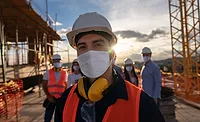Brace Yourselves, Coronavirus’ Impact on the Roofing Industry Will be Felt

With almost 1,000 cases in the U.S. and more than 100,000 worldwide, the novel coronavirus (referred to in the medical community as COVID-19) has quickly become a global threat, not only to individual safety and health, but also to economies and businesses. Originating in Wuhan City, China in December 2019, the virus has rapidly spread to over 100 countries around the world. As more cases are confirmed by the day, the U.S. roofing industry is already experiencing the effects, and must brace itself for the challenges to come.
Preventative Measures for Employers
As COVID-19 continues to spread, it’s crucial for employers to implement safety protocols designed to prevent the spread of the virus among employees. Given the relatively low number of cases confirmed in the United States compared to the rest of the world, most American workers are not considered to be at significant risk of contracting the virus at the time of publication. Nevertheless, employers need to be aware of procedures for navigating the health and well-being of their employees while ensuring employee’s rights are not being violated. Given the lack of experience the American workforce has dealing with large-scale pandemics like COVID-19, there is very little case law or statutory authority for employers to rely on in these situations.
Luckily, OSHA has recently taken the opportunity to remind employers that existing OSHA standards apply to protecting their workers from the coronavirus, including, in particular, OSHA’s Personal Protective Equipment standards, 29 C.F.R. 1910 Subpart 1, and the General Duty Clause, 29 U.S.C. § 654(a)(1). OSHA also noted that its Bloodborne Pathogens standard, 29 C.F.R. 1910.1030, is not directly applicable in regards to coronavirus protections because the virus is not transmitted through blood, but it does offer a framework that may help control some sources of the virus including exposure to bodily fluids.
OSHA has also created a webpage dedicated to providing employers information on the spread of COVID-19, the possible consequences it could have on the overall health of your employees and company, and on establishing standards and guidelines for preventing transmission should one of your employees become infected.
Another good resource for employers is the Equal Employment Opportunity Commission’s advisory opinion on “Pandemic Preparedness in the Workplace," which offers guidance on the responsibility of employers amidst a public health crisis. The advisory opinion suggests that an employer’s ability to question an employee about their health — while generally prohibited — may be broader during a pandemic like COVID-19, citing examples where doing so may be appropriate. Some examples of these situations include requesting information from employees who return from travel about the locations they visited and any symptoms they may be experiencing resulting from such travel, requiring employees exhibiting flu-like symptoms to have their temperature taken prior to returning to the jobsite, and allowing employers to use their discretion in sending an employee home who exhibits flu-like symptoms on the jobsite.
However, these additional measures can only be taken when the employer, based on objective, factual information, determines that the employee poses a “direct threat” — or a significant risk of substantial harm — to the health or safety of other individuals in the workplace. Additionally, despite more lenient restrictions, employers must be careful not to violate their employees’ rights under the ADA, FLSA or Title VII. Keep in mind that any information received by an employer as a result of these inquiries must remain confidential and an employer may not take adverse employment action (termination, demotion, etc.) on grounds that an employee is suspected of or is diagnosed with COVID-19. The purpose of these guidelines is solely to ensure the safety and health of your employees and business, rather than punish employees who may become infected.
Impact on Supply Chain
While the U.S. roofing industry has not yet been affected to the extent of some other countries, the impact of the virus on Chinese production has been devastating for global markets and construction supply chains. Mass public quarantines, curfews, and travel restrictions implemented to help fight the spread of the disease have crippled Chinese manufacturing and shipping sectors, among others. In the roofing industry in particular, the most drastic effects have been on the manufacture and supply of solar roofing systems, with production grinding to a halt in the most affected areas of mainland China — where 60%-70% of the world’s solar roofing panels are manufactured.
However, it’s not just solar roofing materials that are likely to see a decline in production due to the rapid spread of COVID-19. Production of aluminum, plastic, slate, timber and rubber have all declined worldwide since the early weeks of the outbreak — mainly due to the lack of workforce and transportation stoppages plaguing much of Asia. One area that has been hit particularly hard by the virus is China’s Shandong Province, which is not only home to some of China’s largest aluminum manufacturers, but also produces more than 90% of the world’s collated roofing nails.
The most recent estimates suggest that manufacturing plants in the region are currently operating at just 30%, and some project the workforce shortages will continue for the foreseeable future. Some American roofing contractors have already implemented four to six week delays on projects due to this material shortage. It’s not a matter of if, but when the effects will hit your roofing business, how extensive they will be, and how long they will last.
Among the ramifications U.S. roofing companies can expect to begin feeling, if they haven’t already, include higher costs and price fluctuations, material shortages, logistics breakdowns, order cancellations, and extended delays in product fulfillment and shipping. All of that ultimately leads to slower project completion times and potential legal squabbles with both suppliers and project owners down the road. Roofers are urged to begin preparing for these effects now by evaluating their own supply chains from end to end to pinpoint vulnerabilities, identifying potential alternative supply sources, preparing for costs to soar, and making sure they have adequate provisions in their contracts to protect themselves from the increased costs, supply chain delays and interruptions due to the ongoing coronavirus crisis.
Force Majeure Clauses
One of the ways contractors can seek to protect themselves is by including a “force majeure” clause in their contracts. It’s a provision that allocates the risk of performance if performance is delayed indefinitely or stopped completely due to circumstances outside of a party’s control that makes performance impossible, inadvisable, commercially impractical, or illegal. It also provides notice to the parties of the types of events that would cause a project to be suspended or that would excuse performance.
The purpose of the provision is to relieve a party impacted by the force majeure by extending, temporarily suspending or terminating the contract due to unexpected and unavoidable events such as “acts of God,” including severe weather events, earthquakes, landslides, and wildfires. It also covers certain man-made events like riots, wars, terrorist attacks, explosions, labor strikes, and scarcity of energy supplies. To be classified as a force majeure event, the event must be beyond the control of the contracting parties, it cannot be anticipated, foreseeable, or expected, and the event must be unavoidable.
Without a force majeure clause in place, in some jurisdictions, both the owner and contractor would share the risk, but in many others, the risk falls on the shoulders of the contractor. Thus, anything that cannot be anticipated while drafting the contract and factors that could impede progress should be negotiated between the parties and addressed via a force majeure clause.
When seeking to limit exposure, contractors must be specific and clear in their contract language when defining the scope and effect of a force majeure clause to protect themselves from unexpected liabilities. The following elements should be addressed in a force majeure clause:
- What events are considered force majeure?
- Who is responsible for suspending performance?
- Who is allowed to invoke the clause?
- Which contractual obligations are covered by the clause?
- How is the inability to perform determined?
- What happens if the event continues for an extended time period?
For companies that already have force majeure clauses in their standard contracts, it would still be wise to review those provisions to make sure they provide clear, comprehensive, and adequate protections for the company and consider whether terms such as “widespread epidemic,” “pandemic,” and/or “public health emergency” should be added. Courts will often interpret the clause based on what is specifically listed in the contract. Contractors should also review the terms of their existing force majeure clauses in preparation for potentially needing to invoke them for coronavirus-related issues, as many times force majeure clauses contain requirements, such as providing written notice within a certain timeframe and mitigating some of the damages caused by non-performance.
Price Acceleration Provisions
In light of the wide-ranging and potentially long-lasting effects posed by the coronavirus epidemic on construction supply chains worldwide — and specifically, overseas suppliers of roofing materials — contractors should also consider adding terms to their contracts to protect themselves from labor and material price increases in the form of a price acceleration provision. A price acceleration provision generally provides that the roofing contractor may adjust the contract price to reflect the revised actual cost of the labor and materials. Assuming the contractor is using its own labor force, there may not be a significant enough increase in labor costs to warrant an adjustment of the contract. As a result, the price acceleration clause is usually limited to increases in materials over the course of a project.
Price acceleration provisions typically require the contractor to provide the prime contractor or owner with evidence supporting the claim for additional compensation through documentation of the cost increase. Price acceleration clauses also sometimes contain a termination for convenience provision that may allow the contractor to escape a contract if the cost of materials has increased exponentially or the materials themselves have become difficult or impossible to find. This last component is generally disfavored and often removed from the contract by prime contractors and owners because of the uneasiness they have with the idea of a termination for convenience.
Nevertheless, it’s still a worthwhile option to propose in order to provide the contractor with the utmost protection caused by substantial unexpected increases in the price and availability of materials. Below is an example of a standard price acceleration provision that contractors should consider adding to their contracts:
If there is an increase in the actual cost of the labor or materials charged to the Contractor in excess of 5% subsequent to making this Agreement, the price set forth in this Agreement shall be increased without the need for a written change order or amendment to the contract to reflect the price increase and additional direct cost to the Contractor. Contractor will submit written documentation of the increased charges to the Prime Contractor/Owner upon request. As an additional remedy, if the actual cost of any line item increases more than 10% subsequent to the making of this Agreement, Contractor, at its sole discretion, may terminate the contract for convenience.
A roofing contractor may find it difficult to include a price acceleration clause in its contract with a prime contractor because both the owner and the prime contractor are looking for fixed prices prior to the start of the construction. In that situation, the roofing contractor may want to consider buying and storing materials prior to the start of construction to avoid the increases in prices that are expected to occur once the full force of the coronavirus-related disruption to China’s roofing industry supply chains begins to be felt in earnest in the U.S.
Roofing contractors may also want to request a deposit to purchase the requested materials depending on the nature of the job. To the extent that a subcontractor adds a price acceleration provision to their contract, the subcontractor should consider requesting that the prime contractor also add a similar provision in its contract to allow the prime contractor to seek additional funds from the owner for any labor or price acceleration that occurs.
Conscientious Bidding
Roofing contractors should also be cautious and use common sense when providing firm bids for contracts for projects that may not begin construction for several months from the time the proposal is submitted. Under these circumstances, the contractor faces additional exposure for any increases in the costs of labor and materials caused by the negative impacts of the coronavirus on the roofing industry following the bid process. Therefore, estimating those jobs thoughtfully, appropriately, and perhaps more conservatively can potentially make or break a roofing contractor. At least for the time being while the extent of the repercussions of the coronavirus on the market are not yet known, and for many months to come until the epidemic is under control and global supply chains and economies begin to normalize.
Since there is no current vaccine for the coronavirus and the number of infected individuals continues to rise every day, no one can say how long it will take for the virus to be contained and the economy to normalize. So now’s the time for roofing contractors to take steps to mitigate their risks and protect themselves from the wide-ranging and potentially calamitous effects that are expected to continue hitting the U.S. construction industry once the aftershocks from the virus’ impact on China’s manufacturing and supply lines make their way here in full force.
Disclaimer: The information contained in this article is for general educational information only. This information does not constitute legal advice, is not intended to constitute legal advice, nor should it be relied upon as legal advice for your specific factual pattern or situation.
Looking for a reprint of this article?
From high-res PDFs to custom plaques, order your copy today!







